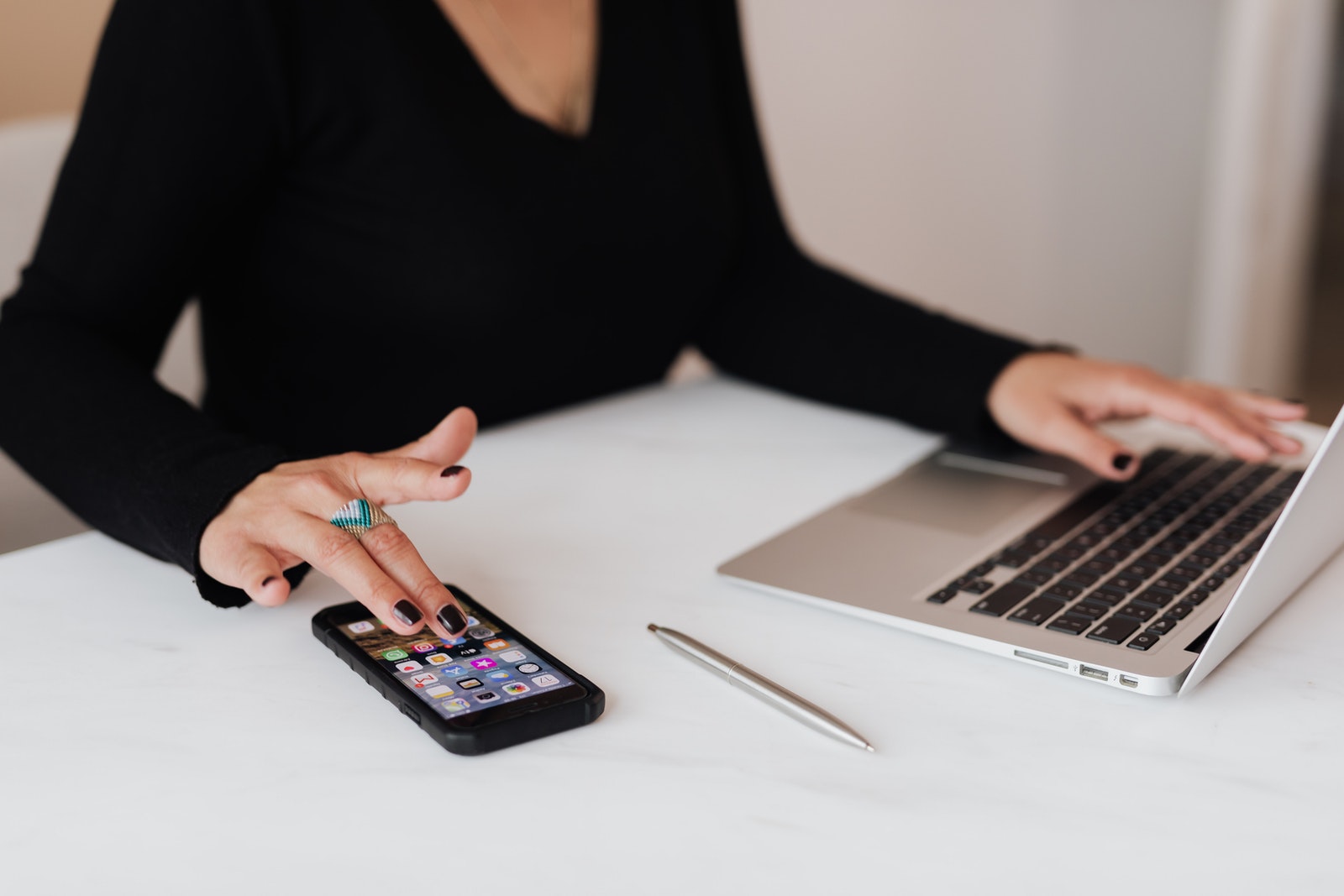Why Doesn’t Multitasking Work? – 7 Common Myths + 8 Things to Try Instead
This post may contain affiliate links, which means I’ll receive a commission if you purchase through my links (at no extra cost to you). Please see my disclosure for more information.
Multitasking. It seems like a dream, right? Getting multiple things done at the same time. Efficiency. Productivity. The best possible way to manage your time.
I hate to be the one to tell you, but multitasking isn’t all it’s cracked up to be. In fact, it can actually significantly decrease your productivity.
Yes, I know that motherhood makes not multitasking darn near impossible. Sometimes you just have to do four things at once. I can usually be found breaking up sibling fights while wiping down counters in between stirring the veggies that are being sauteed for dinner and listening to my husband recount the story of his day at work.
As moms, we have no choice but to multitask to a certain extent. If you have a crying baby, you’re going to wear that baby while you cook. You can still snuggle on the couch for a movie even though you need to respond to a few emails while you watch.
However, for the most part, you should try to focus on one thing at a time – it makes life less overwhelming, and it strengthens your connection to the people you love. Keep reading to find out the hows and the whys 🙂
What is Multitasking?
Multitasking is the performance of multiple tasks at the same time. For example, people who claim to multitask check their email while they’re making a phone call or edit a spreadsheet while playing a game with a child.
Even though most of us try to multitask, what’s actually happening is that our brains are switching between two tasks at lightning speed. But what our brains really want to do, and what would be more efficient, is to focus on one task at a time. Multitasking is exhausting for our brains, and it’s not productive at all.
Think of it as being like multiple tabs open on your web browser. True multitasking would involve paying attention to at least two tabs at the same time. But you’re actually switching from one tab to another so quickly that it doesn’t consciously register.
So, in real life, what you generally think of as “multitasking” is not multitasking at all – you’re task-switching. And in going back and forth between the tabs, your concentration is broken, so your brain needs to re-focus.
And the bad news is that, when you’re asking your brain to constantly switch gears, it gets tired and accomplishes less.

Is Multitasking EVER Good?
If you’re reading this post in complete disbelief, wondering how on earth you’re going to ever get anything done if you can’t do two things at once, don’t worry!
Sometimes multitasking is actually good. There’s no reason why you shouldn’t listen to a podcast or ebook while doing a mindless chore like folding laundry or sweeping the floor. You can read emails while you’re sitting on hold on the phone.
You can do two things at once when one of them doesn’t require 100% of your concentration. Otherwise you’ll find yourself either not working or not listening.
The point is that, generally speaking, what we typically think of as “multitasking” is not good.
Negative Effects of Multitasking
Okay, so maybe multitasking isn’t productive, but it’s still sometimes necessary, so are there any negative effects of multitasking? I hate to be the one to break it to you, but here are some cons to the practice of trying to do mulitple things at once:
- The more you do the quick back-and-forth between two tasks, the more mental energy it takes to get back on task, which causes a decline in productivity.
- You may make more mistakes since your attention is divided between tasks.
- You don’t retain as much information, so you have to repeat work or re-read in order to keep up.
- It can take longer to complete tasks due to the loss of time that happens each time you switch between tasks.

Common Multitasking Myths
Myth #1 – Humans can multitask, no problem!
As amazing as it would be to do two things at once, studies show that our brains just aren’t capable of giving full attention to more than one thing at a time.
When we think we’re multitasking, we’re actually rapidly switching between two tasks. And anytime you make this sort of rapid switch, there’s a greater chance of making errors or missing things, plus your tasks will take longer.
Myth #2 – Multitasking shows others that you’ve got it together and that you’re a master of doing it all.
It seems like it’s a badge of honor to be busy nowadays. We praise each other for how much we’re able to get accomplished while still keeping house and being a mom. Hustling makes us seem “better than.”
But when you tie your identity to being busy and overworked, your self-confidence will take a massive hit once you burn out – because you can’t, in real life, do it all for an extended period of time.
Truthfully, you’re not actually a failure when you figure out that you can’t multitask – you’re just human 🙂 Remember that there’s true strength in knowing and accepting your limits.
And your friends will love you more for your humility and ability to admit that you don’t have it all together all the time.
Myth #3 – Multitasking trains your brain and even makes you smarter.
Unfortunately, the opposite is true. Switching between mental tasks overloads your brain and causes mental fatigue.
A study at the University of London showed that when multitaskers perform cognitive tasks, they experience measurable decreases in IQ similar to those you’d see in people who skip an entire night of sleep!
This is because task-switching overloads your brain and causes it to become fatigued, and a tired brain is less effective. Also, overworking your brain by multitasking causes the release of cortisol, which is a stress hormone – and stress has a negative impact on IQ.
Myth #4 – Multitasking makes you more efficient.
Multitasking is incredibly inefficient. The more you try to do it, the more likely you are to make mistakes.
Have you ever accidentally used baking powder instead of baking soda because you were chatting on the phone while trying to bake cookies? Or had a whole egg in one hand and an eggshell in the other and threw the whole egg into the trash can while dropping the eggshell in the pain?
(That second one has never happened to me. I’ve never had two things in my hands, one piece of trash and one something else, and thrown out the wrong thing. Never.)
And making more mistakes means that you have to go back and redo, thereby decreasing your efficiency.
Myth #5 – Multitasking helps your relationships by allowing you to get more done in less time.
Multitasking makes it impossible to be a present parent – or a present anything. Not only does it harm your brain, it can also harm your relationships as well.
We get so preoccupied with what needs to be done, trying to meet all of the demands of our to-do lists, that we often stop paying attention when our child or spouse is talking to us.
I’m guilty of carrying on with whatever I’m doing when someone is talking to me. I try to listen and respond appropriately, but it doesn’t work very often.
What I should do is completely stop what I’m doing, give the other person my full attention for what typically amounts to a very short period of time, and then go back to what I was doing.
By switching from what you’re doing to fully listening to the other person, you’ll make them feel like they matter, and you’ll notice that you have more patience to deal with whatever they’re wanting to tell you.
Myth #6 – Multitasking decreases stress.
Multitasking is very stressful. It’s stressful to your brain because it’s exhausting, and it’s stressful to your life because you’re more likely to make mistakes – causing the need to go back and fix things.
Doing multiple things at once can have a significant negative impact on your well-being, your motivation, and your productivity.
Myth #7 – Multitasking increases productivity.
If you’re doing two things at once, aren’t you actually getting more done?
Nope, it’s the opposite. Research shows that multitasking can reduce productivity by 40%! This is because of the mental effort it takes to switch rapidly between tasks. You can’t be as effective or efficient when you’re multitasking.
Remember that productivity and time management aren’t about getting more done in less time – they’re about completing the most important things effectively.

What to Do Instead of Multitasking
Now that you know that multitasking isn’t what you think it is, how can you make a change?
#1 – Plan ahead.
I always have a better week when I sit down on Sunday nights and plan out the week ahead. I use a paper planner to log my to-do list, and then, every morning, I look to see what needs to be done that day.
Planning ahead allows me to make sure that I don’t overload any single day of my week. Because when I do accidentally overload my schedule, I get overwhelmed and try to do too many things at once.
When I’m not trying to do too many things at once, I’m happier, my kids are happier, and the whole day just feels better.
#2 – Establish work hours.
If you work, establish work hours and do your best to stick with them. Sometimes you’ll still need to deal with interruptions of the child variety, but having a fairly set schedule will help you stay on track.
And if something work-related comes up and it’s not during those work hours? Give your full attention to your home and family and remember that your time to work is not right now. Giving your full attention to what’s in front of you will help your productivity and keep your stress levels down.
#3 – Stay organized.
I know, I know – this is much easier said than done when you have kids. But if you can keep your home fairly organized, it’ll be easier to focus on your tasks, whether you’re making dinner or making a bunch of phone calls.
#4 – Remember that you can still do two things at once if one task is mental and one is mindless and physical.
Make phone calls while you take your kids for a morning walk. Listen to an audiobook while you fold laundry. Read emails while you walk on the treadmill.
Combining your mindless physical tasks with mental tasks will save a little bit of time.
#5 – Try time blocking.
Time blocking is a time management strategy that can help you focus and get things done more quickly.
To implement, you group similar tasks together and complete them in a certain time block. You can schedule your time blocks based on the flow of your day if you have young kids – no need to schedule hour by hour. Errands can be run in that time period between breakfast and lunch. Checking email or working can be done during naps.
Sometimes I’ll get a work-related text when I’m teaching the kids. I’m easily able to ignore it because I know that my work block is coming later in the day, so I’m better able to focus on the task at hand.
#6 – Create a daily to-do list and stick to it.
A good to-do list helps you prioritize so that you don’t get overwhelmed. I like to prioritize by using the “Big 3” – I focus on completing the three most important tasks every day. These aren’t things that you do as part of your daily routine, but they ARE things that, if they’re the only things you do all day, will make you feel productive and accomplished.
I used to multitask because I was worried that I’d forget to do something if I didn’t do it right. that. second. With an effective to-do list, all of your tasks are right in front of you, so it eliminates the pull to multitask.
#7 – Ask for help.
Being a mom is hard. Whether you work or stay home (or both), asking for help is vital. Whether it’s childcare, housecleaning, or something else that you need, don’t feel ashamed or afraid to ask for help when you feel overwhelmed.
#8 – Prioritize
Sometimes it’s tempting to fall into the trap of multitasking because everything seems equally important. Understanding the relative impact of each task can help you prioritize.
If something comes up (which it always will), you can resist the urge to multitask and decide which thing is most important and act accordingly.
A Challenge
I’m most definitely not a fan of multitasking. But I still think you should figure this out for yourself.
I challenge you to get through ONE day without multitasking. Do one thing at a time and give it your full attention.
I know it will be hard – as moms, we have a lot to juggle. But I’m positive you’ll find that some things are actually easier without multitasking – and you’ll probably get those things done in less time than you would have if you were multitasking.
Try it and see what happens!

The concept of doing more than one thing simultaneously isn’t new. Multitasking has been around forever, and it’ll never completely go away. If you’re a parent, you have to check homework while making dinner and attending to a quiet baby. Heck, making dinner is an exercise in multitasking in itself – you have to attempt the juggling act of getting the main dish and the sides prepped and ready at the same time.
But doing too much at once doesn’t make me a supermom – it just makes me tired.
We have to reject the idea that moms must be all things at all times. You’re only one person.
Multitasking will happen because it’s part of mom life. But let’s challenge ourselves to protect our brains and our sanity by avoiding multitasking as much as possible. Concentrate and stay in the moment by focusing on one thing at a time.
Are you planning to accept my challenge of going an entire day without multitasking? Let me know how it goes!







